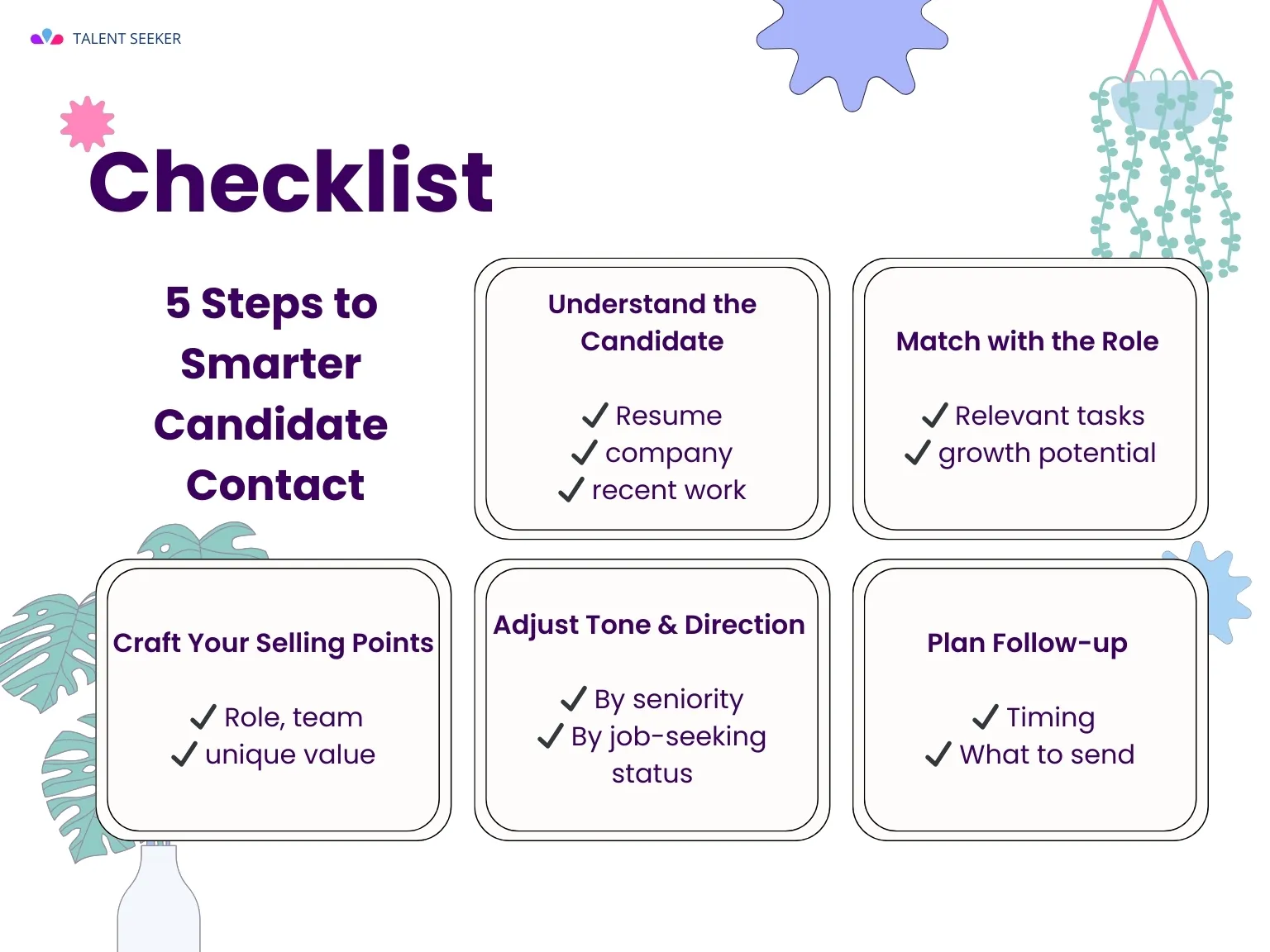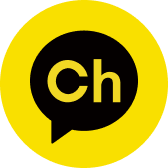Finding great talent is hard. But starting the first conversation? Even harder.
Once you've identified a great candidate through sourcing, the next challenge is this: how do you actually start the conversation?
Especially for passive candidates who aren’t actively looking, that first message can spark interest—or shut the door.
If you’re wondering how to structure your outreach, what tone to use, and how much to say, this guide will help you set a clear standard.
Still figuring out how to find great candidates in the first place?
Start here: Direct Sourcing Strategy Guide for Hiring Teams
Why Your First Message Matters
Ever sent a carefully written message to a promising candidate... and got no response? Or worse, a flat "Thanks, but not interested"?
You probably asked yourself:
"Did I say something wrong? Would a different message have worked better?"
The truth is, your first contact isn’t just about sharing information. It’s the moment the candidate meets your company.
While you may be reaching out to dozens of candidates, for them, this message is often their first impression of your brand.
•
Too aggressive? Feels like pressure.
•
Too formal? Feels like marketing.
•
Too long? No one reads it.
•
Too short? Feels lazy.
There is no one perfect formula. But one thing is clear:
Your message should be tailored to the candidate.
So let’s look at how to craft a message that actually opens doors.
What to Prepare Before Reaching Out
Before sending a message, your first job is to understand the candidate’s profile and background.
Whether it’s email, LinkedIn, or phone, if you approach a candidate without understanding their experience or goals, your message might miss the mark.
Pre-Outreach Readiness Checklist
Step | What to Check | Notes/Examples |
1. Understand their current status | ||
Reviewed latest experience | LinkedIn, GitHub, Notion, etc. | |
Researched current company/industry | Useful for identifying competitors or alignment | |
Recent projects or accomplishments | “Led new dashboard redesign last quarter.” | |
2. Map their experience to your role | ||
Relevant experience identified | "Refactored legacy systems in previous role." | |
Growth or stretch opportunities spotted | "Can now take ownership of cross-functional features." | |
Value they could deliver in your context | "Path from PM to PO possible here." | |
3. Prepare your selling points | ||
Clear definition of role/responsibilities | JD summary or 2-3 key points | |
Team/org value propositions | Tech stack, autonomy, leadership, culture | |
Candidate-relevant appeal | "Engineers have freedom to propose and test solutions." | |
4. Tailor tone and message direction | ||
Adjusted for junior/senior | Growth vs. impact emphasis | |
Adjusted for active/passive | Direct ask vs. curiosity spark | |
First and final lines planned | "Noticed your profile" + "Reply when you’re free" | |
5. Have follow-up strategy | ||
Planned follow-up sequence | 3-day/7-day reminders | |
Prepared follow-up materials | Team intro, JD link, mini case, etc. |
Spending too much time writing messages or researching candidates?
TalentSeeker automatically matches candidates to your JD, writes the message, and sends it out on your behalf.
Tailor Your Approach Based on Job-Seeking Intent
When sending your first message, the first thing to consider is: Is this person even looking for a job?
Most of the time, they’re not. So the way you write your message depends heavily on whether they’re actively searching—or not.
1) For Active Candidates: Be Clear and Direct
These candidates are probably receiving multiple offers already. The goal is to stand out with clarity and speed.
•
Spell out what the role is
•
Emphasize timelines and process clarity
•
Help them picture what they could contribute
Message Template
"We’re currently looking for someone to lead the backend architecture of our new service.
The interview process includes just two stages and can be wrapped quickly.
Let me know if this sounds interesting to you."
2) For Passive Candidates: Be Subtle and Intriguing
These candidates are not looking. So avoid pushing them to act. Instead, spark curiosity and make space.
•
Replace "Apply now" with "This might be worth a look."
•
Offer the option to just chat
•
Let them decide on the timing
Message Template
"I came across your profile and found your background really impressive.
Even if you’re not actively considering a move, I wanted to share a role that might interest you when the time is right."
Choose the Right Contact Channel: DM, Email, or Phone
Once you've prepared the message content, the next question is: how should you reach out? Each method—DM, email, or phone—has its own advantages depending on the candidate’s profile and preferences.
DM (Text, LinkedIn InMail, etc.)
Short, casual, and effective for starting low-pressure conversations
More and more candidates prefer async, lightweight channels like DMs. They're less formal and more approachable, especially for passive talent.
•
Keep it short and punchy
•
Focus on one hook (e.g., shared interest, recent project)
•
If no response, follow up once after 3–5 days
•
Great for startup/tech candidates, junior profiles, or passive outreach
Sample DM
Hi [Name], I’m [Your Name] from [Company].
I came across your experience on [X Project], and I think it aligns well with something we’re building.
Would you be open to a quick chat?
Professional and detailed, but needs to feel personalized
Email is still the standard for formal communication, especially for senior or international candidates. But boilerplate emails get ignored fast. Personalization is key.
•
Use a three-part structure:
1.
Short intro and why you’re reaching out
2.
Why they might be a fit
3.
Easy call to action (no pressure)
•
Include a link to JD or team page
•
Best for senior candidates or when more info is needed upfront
Sample Email
Hi [Name],
I’m [Your Name], a recruiter at [Company].
I was really impressed by your experience on [Project], and we’re currently hiring for a role that seems like a strong match.
Would love to share more details if you’re open to it. Let me know!
Phone
High-impact, real-time—but only when used at the right moment
Phone calls can build trust quickly and allow real-time Q&A, but they require more setup and sensitivity.
•
Never cold call without checking availability
•
Always start with who you are and why you’re calling
•
Use a warm, conversational tone
•
Ideal for: warm referrals, urgent roles, or re-engaging interested candidates
Phone Opener Template
Hi [Name], this is [Your Name] from [Company].
I know this call might be unexpected, so I’ll be brief—I’d love to quickly explain why I’m reaching out.
Trying to reach dozens—or even hundreds—of candidates in one day? Writing personal messages for each one takes hours.
TalentSeeker personalizes each message at scale and sends them out automatically using AI-powered sequences.
Tailor Your Message for Juniors vs. Seniors
One of the most common outreach mistakes is using the same tone, structure, and message across all candidate types.
But how you pitch your opportunity should vary depending on whether you’re contacting a junior or senior profile..
Junior Candidates – “Will I grow and learn here?”
Focus Area | What to Emphasize |
Growth culture | Code reviews, mentorship, cross-team exposure |
Learning opportunities | Onboarding plans, study groups, access to training |
Career clarity | “Here’s how your role can evolve in 1–2 years.” |
Psychological safety | “Everyone’s opinion is heard, and mistakes are part of learning.” |
Sample Message
Our team has several engineers in the 2–3 year experience range, and we actively run study groups and regular code reviews.
If you're looking to learn fast and grow alongside solid peers, we’d love to talk.
Senior Candidates – “Can I drive impact here?”
Focus Area | What to Emphasize |
Ownership & decision-making | Scope, authority, leadership responsibilities |
Business/technical impact | Opportunity to shape architecture, scale teams, influence strategy |
Leadership proximity | Regular exposure to execs like CTO/CEO |
Org maturity | Investment, roadmap, technical direction, team culture |
Sample Message
This role sits at the heart of our new platform, with full ownership of backend architecture.
You’d work closely with the CTO and play a key role in setting our engineering direction moving forward.
What if They’re In Between?
Sometimes you’re not sure—5 years of experience, maybe senior title, but junior mindset? In these cases, blend growth and leadership angles.
Sample Message
We see this as a chance to both make a meaningful contribution and expand into a new domain.
It’s a great fit if you’re looking for both impact and learning.
Struggling to frame the right message depending on a candidate’s experience level?
TalentSeeker analyzes resumes and JDs to generate tailored messages with the right tone and value proposition—even for less experienced recruiters.
Common Mistakes to Avoid
Good intentions can still lead to bad impressions.
Even experienced recruiters make mistakes that unintentionally push candidates away. Here are some of the most common pitfalls—along with how to avoid them.
Mistake 1: Offering false certainty
"Your profile looks amazing—you’ll definitely pass our screening!"
It might sound encouraging, but making guarantees about hiring outcomes is risky.
One candidate I messaged didn’t make it past the first round, and they responded:
“Why did you say I’d pass when I didn’t even get an interview?”
"Your background stood out, and our team is reviewing profiles closely. I’m hopeful we’ll get to move forward."
Mistake 2: Over-selling the culture
“We’re completely flat, fully autonomous, and 100% experimental.”
These sound great—until the candidate joins and finds out otherwise.
One candidate told me:
“What you described as ‘freedom’ actually felt like chaos.”
“We give team leads a lot of decision-making power, but some approvals still go through our head of product.”
Mistake 3: Sharing confidential information
I once tried to impress a candidate by hinting at a funding round:
“We’re actually closing a major investment soon…”
A week later, they referenced it on LinkedIn. I hadn’t realized it wasn’t public.
Stick to approved talking points, especially around:
•
Funding
•
Reorgs
•
Strategic pivots
Mistake 4: Pushing too hard, too fast
“Would you be able to submit your resume today?”
“Can we schedule the first round this week?”
This might seem efficient—but it can feel pushy.
"If this sounds interesting, I’d love to continue when the timing feels right for you."
Contacting candidates isn’t just about getting replies—it’s about building trust.
Tips for Better Communication
Before you hit send or make that call, here are a few final tips that can make a big difference:
•
First impressions happen fast.
The first 30 seconds (or the first sentence) often set the tone.
Start with a warm, confident intro like:
"Let me quickly explain who I am and why I’m reaching out."
•
Keep your intro short and clear.
1–2 sentences max. Say who you are, where you’re from, and why you’re contacting them.
•
Prepare for FAQs.
Candidates will ask about compensation, team structure, interview process.
Have those answers ready or know where to point them.
•
Know the role inside and out.
Don’t get caught off guard when asked about tech stacks, reporting lines, or product direction.
Be ready to explain the "why" behind the role.
Want to sound more confident and prepared when talking to candidates?
Wrapping Up
Reaching out to candidates isn’t just about filling a role—it’s about entering someone’s career journey with clarity, empathy, and respect.
Yes, finding great candidates is hard. But starting the conversation well? That’s where the real magic happens.
And with TalentSeeker, you don’t have to do it alone:
•
Match candidates to the JD automatically
•
Let AI write and send outreach messages
•
Set personalized sequences that scale to hundreds of contacts
•
Equip junior recruiters with senior-level messaging instantly
Start smarter conversations powered by AI.







